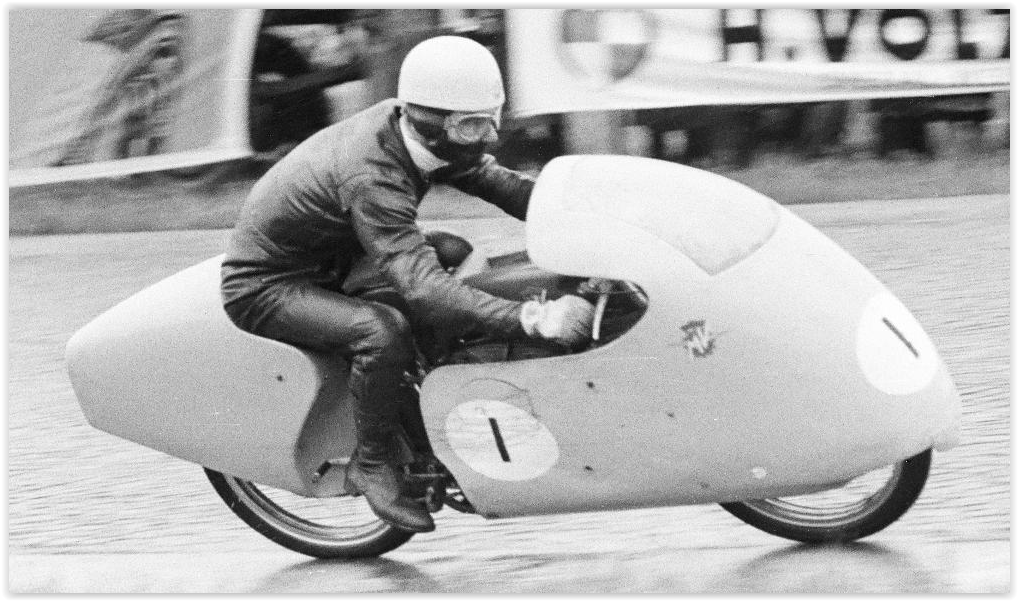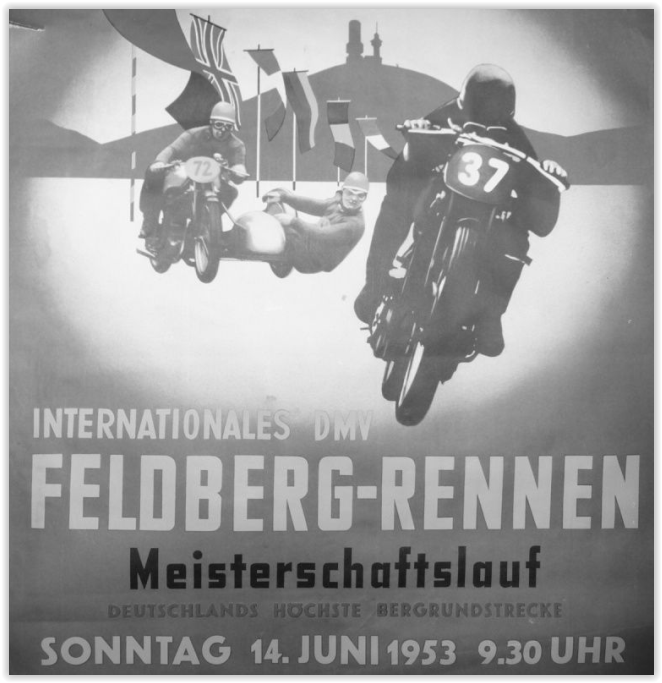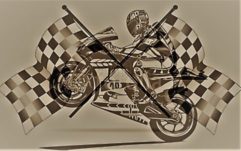
The second third of the season with round 3 of the World Championship
After two of only 6 rounds since last year, the situation didn’t look particularly encouraging for all the defending champions before the TT continued on to Assen. Ubbiali had found a bitter opponent in Provini in the smallest class, who had already beaten him twice in a row. In the 250s he had won the World Cup opener at the Hockenheimring premiere, but after his zero at the TT he was currently only third in the interim rankings, tied with teammate Luigi Taveri behind Sandford and Colombo. The reigning 350 cm³ world champion Bill Lomas, on the other hand, had completely missed the start of the season after his bad crash in Imola, as had superstar Geoff Duke with the same fate. 500cc defending champion John Surtees also didn’t get off to the desired start in the 1957 season and only had a second place finish. In this regard, it was urgent for all reigning world champions to score important points in the Netherlands so that the train to defend their title would not finally run out. But at the Grand Prix in Assen, things were anything but pleasant for some of them.

Grand Prix of the Netherlands up to 125 cc
Defending champion Carlo Ubbiali (MV Agusta) was eliminated after a serious fall in training. It was the first time in a long time that the Italian was out with a hand injury and so the 1957 World Championship was as good as over for the man from Bergamo. It was Tarquinio Provini who controlled the 125cc race in the absence of his strongest compatriot and competitor. With a lap record and an average of 123.48 km/h (76.73 mph), the Italian gave his opponents no chance. Only Roberto Colombo (MV Agusta) was able to keep up with the fast man from Roveleto di Cadeo (near Piacenza), but he was still 43 seconds behind the winner at the finish. Behind him, his factory teammate Taveri made it onto the podium for the second time in the 125cc class this season after the Tourist Trophy. A little over two minutes behind Provini, his Mondial teammate Sandford saw the checkered flag, followed by Libanori (MV) and Sammy Miller (Mondial. The Czechoslovakian Bartos missed out on the final points finish with seventh place on his CZ.

The Assen quarter liter class race
In the absence of defending champion Ubbiali, who was injured in his hands, there was a real Mondial festival. Sandford had set the fastest time in training, but he had to bow to his teammate Provini. The Italian factory team’s triple triumph was completed by third-placed Miller, who would have crossed the finish line ahead of the best MV Agusta from Colombo had it not gotten off the track and crashed. Fortunately, the Italian was not seriously injured and his brand colleague Libanori finished fourth in his place. The lap record also fell in this race with an average speed of 128 km/h (79.54 mph). Thanks to Frantisek Stasny, the small team from Czechoslovakia at least got valuable points here thanks to his fifth place. The last of these was taken by Guzzi private rider Wheeler ahead of the German Beer on Adler.

The defending champion’s end to his career overshadowed the 350cc race
Bill Lomas made his first return from injury sustained in Imola. Contrary to various incorrect reports, it was not the 350cc race for the “Conchiglia d’Oro” (Shell Gold Cup) that put an end to his very successful but far too short career, but rather his crash in training Dutch GP in Assen. With severe head injuries, he not only had to forego the races in the larger two classes, but from then on he had to give up his famous helmet and only wear it for veteran events. While Geoff Duke had to postpone his return until the Belgian GP, Dale also crashed in the race and was out of action until the end of the season with a broken ankle. Even Mc Intyre didn’t get through training without falling, but the Scot remained uninjured. He also took the lead from his Gilera factory team colleague Liberati shortly after the start of the race. Dale also caught up with the two a little later and then, surprisingly, it was Campbell who was able to move up to P2 shortly afterwards. An exciting battle for position developed when Dale crashed out. The lead changed several times and in the end it was Campbell on the Moto-Guzzi who was ahead at the finish, followed by Mc Intyre, Liberati, Brett on the fastest Norton, Bryen, Hartle and Minter (all Norton).

Victory for the defending champion in the premier class
With second place at the Tourist Trophy, John Surtees was able to maintain his chances of defending his title before heading to the Dutch TT. A tough duel for the lead broke out right from the start between the Englishman on his MV Agusta and the Scot Mc Intyre (Gilera). Behind them, a battle for positions broke out between Campbell on the Guzzi V8 and Liberati (Gilera). A crash by Mc Intyre meant that the two were soon fighting for second place, while Surtees pulled away safely and took the checkered flag with a lead of over half a minute over his pursuers. But the Australian also failed with his technical marvel and in the end Zeller inherited third place from Campbell on the BMW behind Liberati. Before he crashed in the duel with Surtees, Mc Intyre had conjured up a new record lap on the asphalt.


Many absentees in the neighboring country for the 4th of 6 rounds
The short onward journey from Assen to nearby Spa-Francorchamps was of course very convenient for the protagonists of the 1957 World Championship, at a time when travel times were much longer. But this time this was of little use to many world-class pilots because the list of absentees was larger than it had been for years. In Belgium, in addition to the seriously injured Lomas, the defending champion up to 350cc, the two-time world champion in the two smallest classes, Carlo Ubbiali, was also missing. In addition, superstar Geoff Duke had not yet recovered sufficiently from his crash injuries at Imola in April and Mc Intyre and Dale also had to pass after their crash in the Dutch GP the previous weekend. Bill Lomas would never return with his fractured skull base and Dale, with two broken ankles, wouldn’t have been able to push his machine anyway. A severe concussion prevented Mc Intyre from getting back in the saddle after his fall in Assen. But despite the numerous absent stars, there was of course racing in the Ardennes and there was a preliminary decision in the smaller classes, although there were still two races to be held afterwards.

Tragic starting position before the race in the smallest category
After his second place at the season opener at the Hockenheimring and two victories after that, everyone was excited to see whether Mondial ace Tarquinio Provini would achieve the hat trick in Spa. Without his arch-rival Ubbiali and the withdrawal of Gilera from the category up to 125 cc with top rider Romolo Ferri, the task had become much easier for Provini. The sudden death of Ferruccio Gilera (the son of the company boss) in October 1956 now cast a large shadow over all Gilera racing activities. After Ferri’s failure at Hockenheim, the 125cc class was the first victim and it would soon be announced that the Italian manufacturer would say goodbye to racing completely. What was particularly tragic, however, was the reason why MV Agusta did not even start the race in this category after training. Incidentally, the German Josef Knebel had already lost his life in sidecar training in Assen and just a week later the black streak continued in neighboring Belgium.

Another top rider lost his life in Spa-Francorchamps
Roberto Colombo was one of the most successful drivers in the smaller classes from 1952 onwards. The northern Italian, born on January 5, 1927, was the first foreigner to be part of the NSU team when the German manufacturer made its debut in the fourth year of the world championship. Before that, the best drivers and brands from Germany were not even allowed. Roberto was only signed by Neckarsulm at the end of the year and immediately scored two points with his fifth place at the season finale in Monza. After that, NSU relied on local pilots and from 1954 onwards Colombo achieved some notable successes with MV and Moto-Guzzi machines, crowned with second place at the last World Championship round in Barcelona. The following year he started in the 350s and achieved his second podium of his career with third place at the French GP on a private Guzzi. In the 1955 season, the Italian even competed in three categories and came fourth in the world championship up to 250 cc.

The final breakthrough and the sudden end
Roberto was accepted into the MV factory team in 1957 and continued to impress. However, his career ended abruptly with the fatal accident on the Spa-Francorchamps circuit during official testing when he lost control of his MV in the Stavelot corner. The pilot suffered very serious injuries and initial medical treatment was unsuccessful. The machine went straight off the track and crashed down a deep embankment. The MV Agusta works driver suffered serious rib and spinal injuries and remained lying down for a long time before rescue workers reached him. There were no doctors at the track’s medical center and the announcer urgently called for a doctor. When two doctors finally came running, the ambulance broke down, which further delayed the rescue. Roberto Colombo died on July 6, 1957 while being transported to the hospital. As third in the World Championships up to 125cc and lying in P2 in the interim rankings, all of MV’s hopes rested on its shoulders after Ubbiali’s injury. This burden may have been too heavy for Rennfahre, who comes from Casatenovo (north of Milan).


The 125cc race with the favorite victory
After Gilera didn’t even compete with Ferri and Galliani and MV was also missing, there were only eight pilots at the start. After a short time, Provini was already well ahead of his factory team colleague Miller and all other pursuers. The Italian also drove a new record lap with an average of 166.59 km/h (103.51 mph), truly pulverizing the existing record and being more than 4 km/h faster. This demonstration drive by Provini didn’t create much excitement and when his brand colleague Miller also had to retire with ignition problems, the race was finally decided early. Taveri (MV) achieved one of the best results of the season with second place ahead of Sandford on another factory Mondial, with the Czechoslovakian Bartos, Webster, Maddrick and Tinker (all MV) already laps behind.


The 250cc Belgian Grand Prix
As in the smallest class, Provini dominated the training here and was considered the overwhelming favorite without competition from the injured Ubbiali. The Italian would definitely have won the race by a significant margin if his battery hadn’t suddenly broken. Hartle on the MV Twin was already over a minute behind at this point. The Englishman had just been signed by Conte (Graf) Agusta after Fortunato Libanori, who was brought in for Assen as Ubbiali’s replacement, did not show the desired performance with the ranks 4 to 250 and 5 to 125 cc. With Hartle, however, Spa had a stroke of luck and the fast 23-year-old young man from Chapel-en-le-Frith (south-east of Manchester) promptly thanked him for the trust placed in him with a surprising victory. As a thank you, he received a contract from MV for the next season. Sammy Miller was beaten by 7.1 seconds in second place ahead of his Mondial factory team colleague Cecil Sandford, who followed at a respectable distance. Wheeler took fourth place ahead of CZ factory pilot Bartos from Czechoslovakia and Günter Beer on his private Adler.


The race up to 350 cc in Spa-Francorchamps
Held as the second race of the day, the most-named favorite was also expected to drop out when, after John Hartle on his private Norton (on lap two), John Surtees dropped out on lap five. Keith Campbell set the fastest time in training with his Moto-Guzzi and came out on top after the start, ahead of his factory team colleague Bryen. While the fastest in training never gave up his lead until the finish, behind him his Australian compatriot and Liberati fought for second position on the Gilera, which was fastest in the absence of Duke and Mc Intyre. After the failures of Hartler and Surtees, who had been in P4 until then, Milani was forced to make a pit stop to change the spark plugs, which threw the Italian far back. That left Bob Brown, who was driving Duke’s factory Gilera as a replacement, in fourth place. But behind him, Montanari put pressure on the third-fastest but private Guzzi and a little later the veteran was past the Australian and pulled away slightly from him. Nothing changed until the end and Colnago took the last championship point with 6th place on the factory Guzzi.

The premier class with another big name missing
After third place in Assen, there was another absentee, BMW ace Walter Zeller. For the German, however, it wasn’t an injury that forced him to give up, but rather a personal reason. Because his brother Kurt had died, he was forced to stop in the middle of the season in order to immediately take care of his parents’ business (a steelworks in Hammerau). This meant that BMW was immediately without a works rider, but the company from Bavaria was to attract attention with a very surprising signing at the end of the season. Because the race up to 500 cc was overshadowed by a scandal as a result of officials’ questionable interpretation of the regulations, there were quite rightly a hail of protests from the Gilera competition.

The second scandal at the Belgian Grand Prix
Despite his serious injuries during training, Roberto Colombo might have survived if he had received quick medical attention. If the officials hadn’t been so irresponsible as to not ensure prompt and reliable first aid for the pilots, the Italian would have at least had a chance. But when it came to their own regulations, those responsible at the FIM once again proved to be highly fallible and damaging to the sport they were supposed to serve. We had already reported in Part 4 from 1954 about how scandalous they had behaved towards Fergus Anderson at the time and in Part 1 from 1956 there is another example of their outrages. In Spa-Francorchamps, she and the organizer made themselves ridiculous. This time it started before the 500cc race, when the Gilera team manager noticed ignition problems with Liberati’s engine and asked the race management to swap it with Bob Brown’s machine. After consultation with the FIM, the latter gave their approval, whereupon Liberati entered the race with Brown’s machine – and even his starting number.

Black flag for the eventual winner – a bad sporting joke
Of course, it was immediately clear to everyone involved that Gilera’s actions, approved by the race management, were absolutely irregular. That’s why there were justified protests from the competition during the race. The team and its driver Liberati had violated the regulations twice with the wrong start number of a teammate on his motorcycle. At most, changing the ignition would have been allowed, although highly questionable, as an exception and promised before the start. In order not to complete the chaos caused, the officials should have recognized this on site and taken the Italian out of the race with a black flag. But they obviously lacked the courage to do so and so Liberati was the first to cross the checkered flag, but was disqualified by the race management shortly afterwards. But this decision was also overturned by the FIM months later due to a protest from Gilera. It couldn’t have been more inconsistent and incompetent. Incidentally, Gilera ultimately withdrew from factory participation in the World Championship for the next season. For more information, see the next two parts on 1957 and 1958.


Unless otherwise stated, this applies to all images (© MotoGP).

No Comments Yet